Report on Intelligent Systems for Data Warehouse Systems - MITS5509
VerifiedAdded on 2022/08/23
|8
|2221
|22
Report
AI Summary
This report provides an in-depth analysis of an academic paper focusing on intelligent systems for data warehouse systems. The paper examines the role of business intelligence (BI) and artificial intelligence (AI) in improving business functions and decision-making processes. It explores the relationship between big data, data warehousing, data mining, and business analytics, highlighting the benefits of BI systems for both short-term and long-term organizational performance. The report critically analyzes the paper's methodology, including its literature review, framework for BI business value, and the impacts of BI investments. The author reviews 106 papers and uses graphs to present the results. The report also discusses the limitations of BI systems and the importance of data analysis. The conclusion emphasizes the positive outcomes of BI systems and the need for their application in decision support and strategic planning. The report also highlights the role of AI in improving the performance of an organization. This report is available on Desklib, a platform that provides AI-based study tools for students.
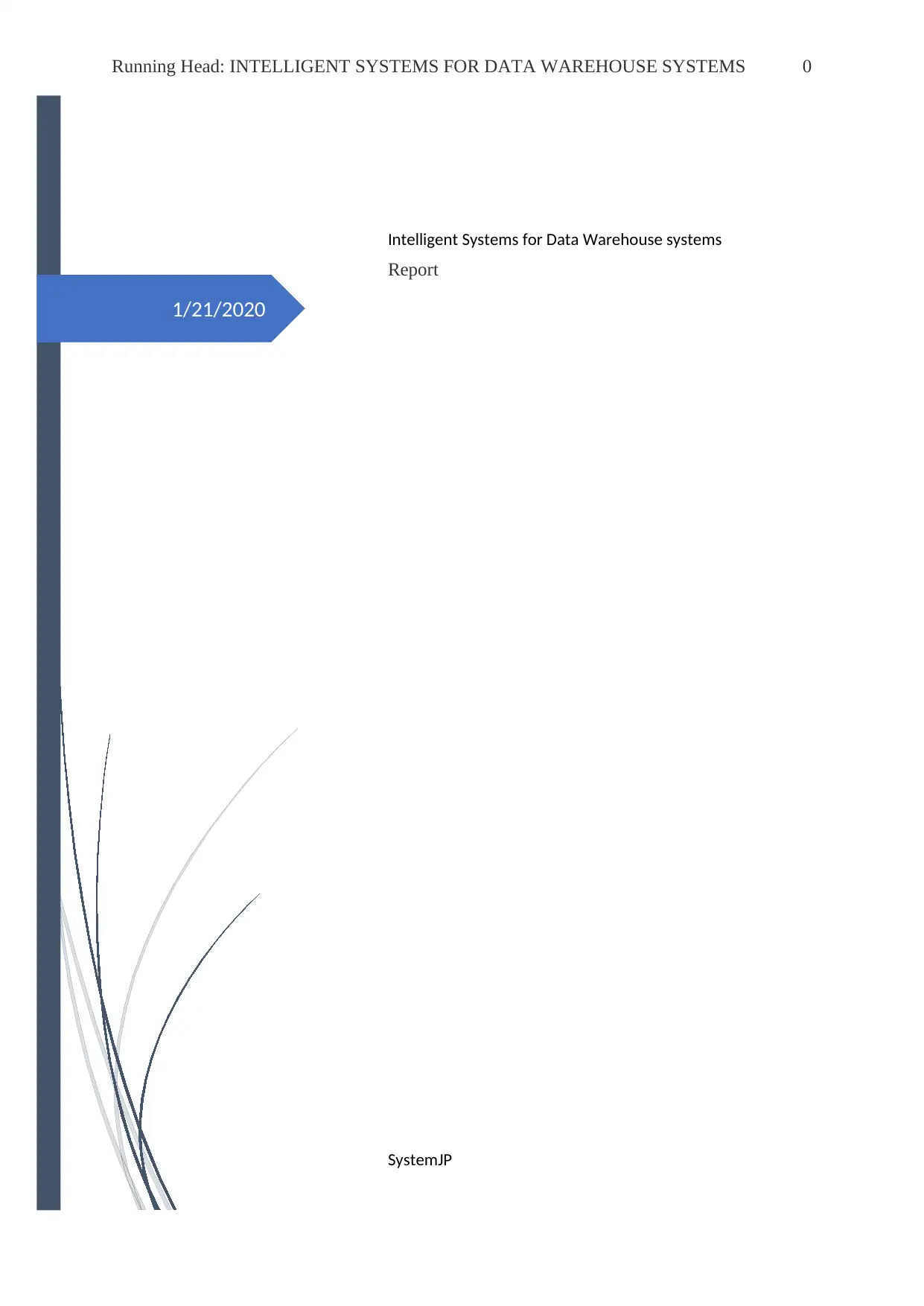
1/21/2020
Running Head: INTELLIGENT SYSTEMS FOR DATA WAREHOUSE SYSTEMS 0
Intelligent Systems for Data Warehouse systems
Report
SystemJP
Running Head: INTELLIGENT SYSTEMS FOR DATA WAREHOUSE SYSTEMS 0
Intelligent Systems for Data Warehouse systems
Report
SystemJP
Paraphrase This Document
Need a fresh take? Get an instant paraphrase of this document with our AI Paraphraser
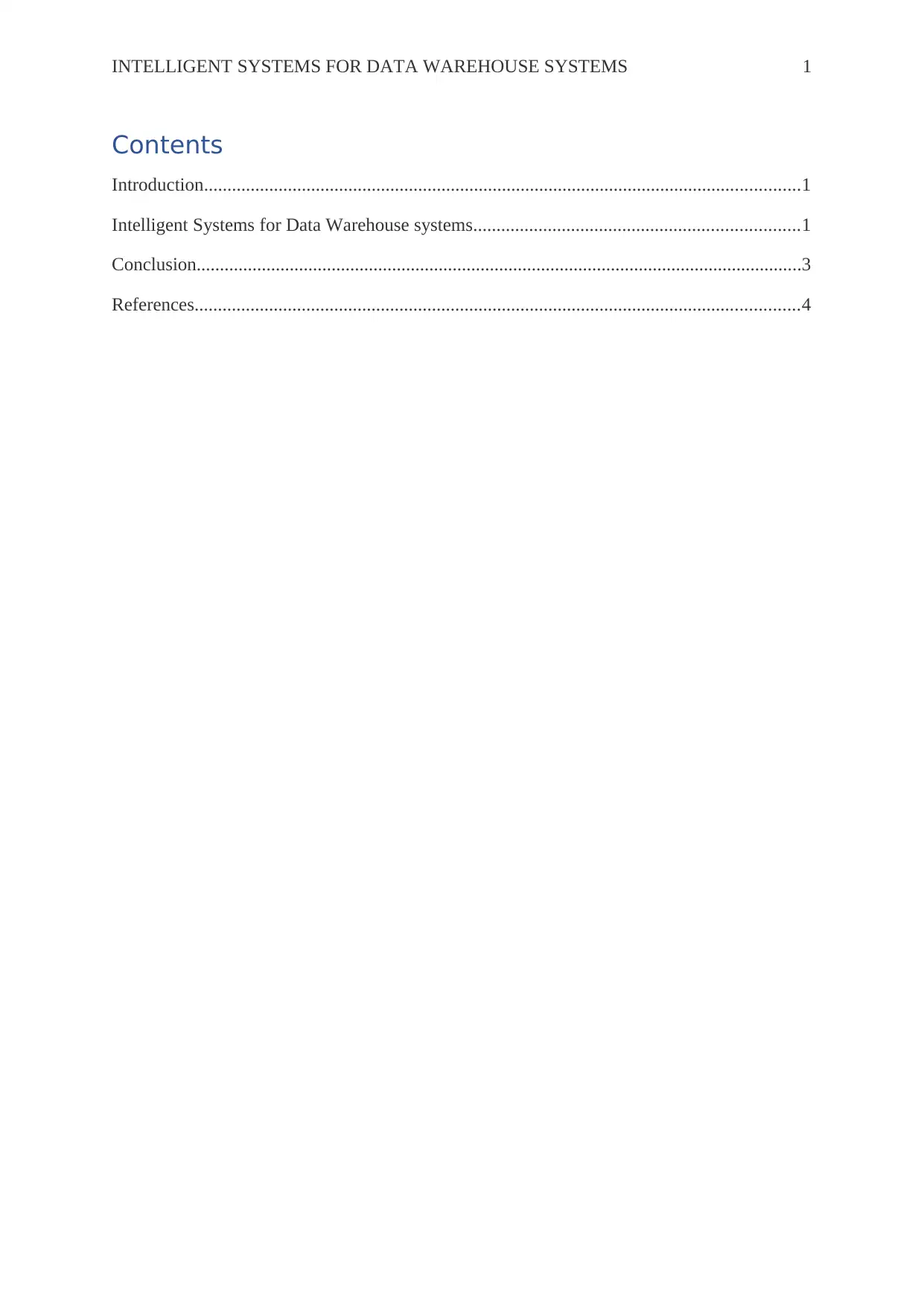
INTELLIGENT SYSTEMS FOR DATA WAREHOUSE SYSTEMS 1
Contents
Introduction................................................................................................................................1
Intelligent Systems for Data Warehouse systems......................................................................1
Conclusion..................................................................................................................................3
References..................................................................................................................................4
Contents
Introduction................................................................................................................................1
Intelligent Systems for Data Warehouse systems......................................................................1
Conclusion..................................................................................................................................3
References..................................................................................................................................4
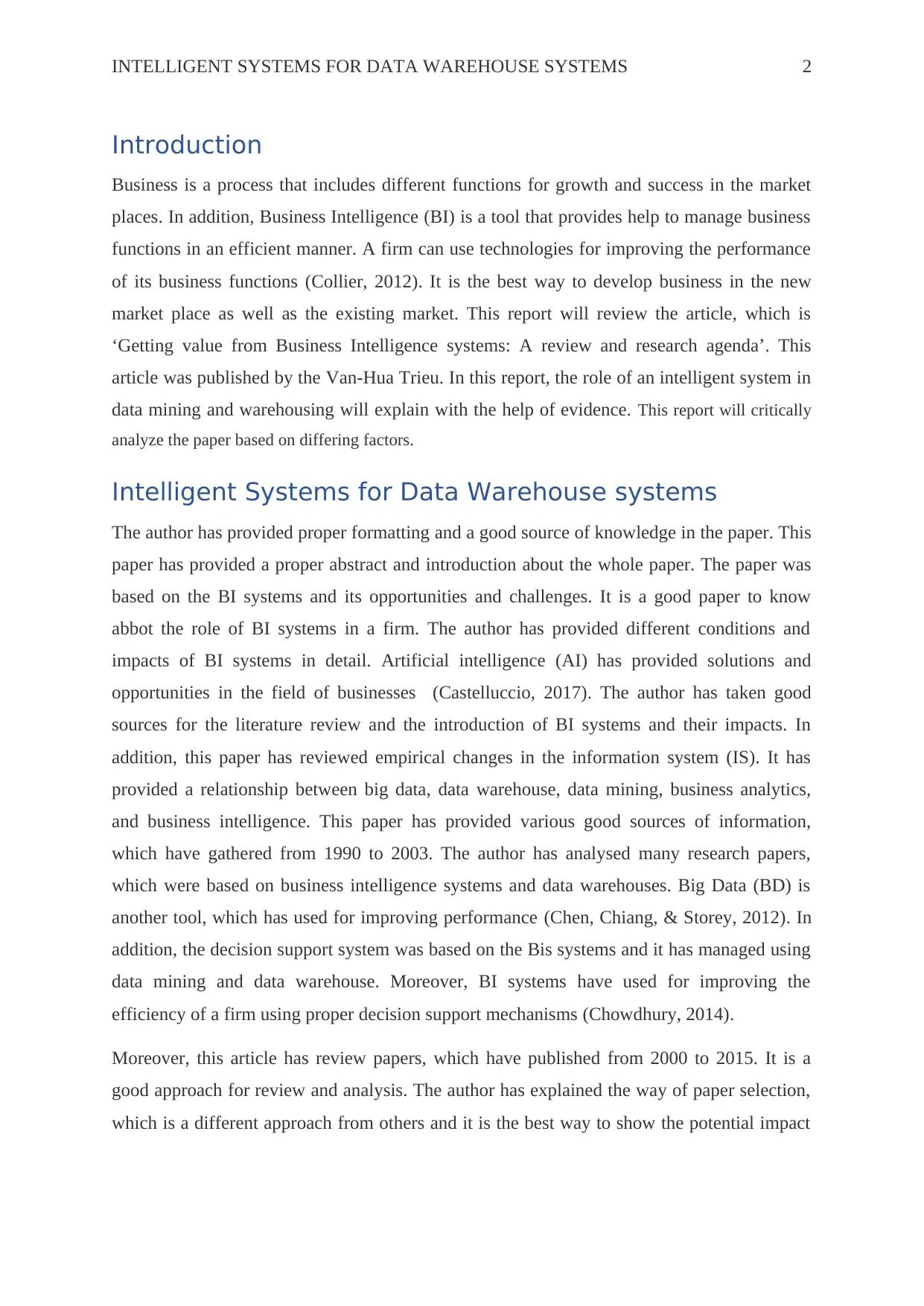
INTELLIGENT SYSTEMS FOR DATA WAREHOUSE SYSTEMS 2
Introduction
Business is a process that includes different functions for growth and success in the market
places. In addition, Business Intelligence (BI) is a tool that provides help to manage business
functions in an efficient manner. A firm can use technologies for improving the performance
of its business functions (Collier, 2012). It is the best way to develop business in the new
market place as well as the existing market. This report will review the article, which is
‘Getting value from Business Intelligence systems: A review and research agenda’. This
article was published by the Van-Hua Trieu. In this report, the role of an intelligent system in
data mining and warehousing will explain with the help of evidence. This report will critically
analyze the paper based on differing factors.
Intelligent Systems for Data Warehouse systems
The author has provided proper formatting and a good source of knowledge in the paper. This
paper has provided a proper abstract and introduction about the whole paper. The paper was
based on the BI systems and its opportunities and challenges. It is a good paper to know
abbot the role of BI systems in a firm. The author has provided different conditions and
impacts of BI systems in detail. Artificial intelligence (AI) has provided solutions and
opportunities in the field of businesses (Castelluccio, 2017). The author has taken good
sources for the literature review and the introduction of BI systems and their impacts. In
addition, this paper has reviewed empirical changes in the information system (IS). It has
provided a relationship between big data, data warehouse, data mining, business analytics,
and business intelligence. This paper has provided various good sources of information,
which have gathered from 1990 to 2003. The author has analysed many research papers,
which were based on business intelligence systems and data warehouses. Big Data (BD) is
another tool, which has used for improving performance (Chen, Chiang, & Storey, 2012). In
addition, the decision support system was based on the Bis systems and it has managed using
data mining and data warehouse. Moreover, BI systems have used for improving the
efficiency of a firm using proper decision support mechanisms (Chowdhury, 2014).
Moreover, this article has review papers, which have published from 2000 to 2015. It is a
good approach for review and analysis. The author has explained the way of paper selection,
which is a different approach from others and it is the best way to show the potential impact
Introduction
Business is a process that includes different functions for growth and success in the market
places. In addition, Business Intelligence (BI) is a tool that provides help to manage business
functions in an efficient manner. A firm can use technologies for improving the performance
of its business functions (Collier, 2012). It is the best way to develop business in the new
market place as well as the existing market. This report will review the article, which is
‘Getting value from Business Intelligence systems: A review and research agenda’. This
article was published by the Van-Hua Trieu. In this report, the role of an intelligent system in
data mining and warehousing will explain with the help of evidence. This report will critically
analyze the paper based on differing factors.
Intelligent Systems for Data Warehouse systems
The author has provided proper formatting and a good source of knowledge in the paper. This
paper has provided a proper abstract and introduction about the whole paper. The paper was
based on the BI systems and its opportunities and challenges. It is a good paper to know
abbot the role of BI systems in a firm. The author has provided different conditions and
impacts of BI systems in detail. Artificial intelligence (AI) has provided solutions and
opportunities in the field of businesses (Castelluccio, 2017). The author has taken good
sources for the literature review and the introduction of BI systems and their impacts. In
addition, this paper has reviewed empirical changes in the information system (IS). It has
provided a relationship between big data, data warehouse, data mining, business analytics,
and business intelligence. This paper has provided various good sources of information,
which have gathered from 1990 to 2003. The author has analysed many research papers,
which were based on business intelligence systems and data warehouses. Big Data (BD) is
another tool, which has used for improving performance (Chen, Chiang, & Storey, 2012). In
addition, the decision support system was based on the Bis systems and it has managed using
data mining and data warehouse. Moreover, BI systems have used for improving the
efficiency of a firm using proper decision support mechanisms (Chowdhury, 2014).
Moreover, this article has review papers, which have published from 2000 to 2015. It is a
good approach for review and analysis. The author has explained the way of paper selection,
which is a different approach from others and it is the best way to show the potential impact
⊘ This is a preview!⊘
Do you want full access?
Subscribe today to unlock all pages.

Trusted by 1+ million students worldwide
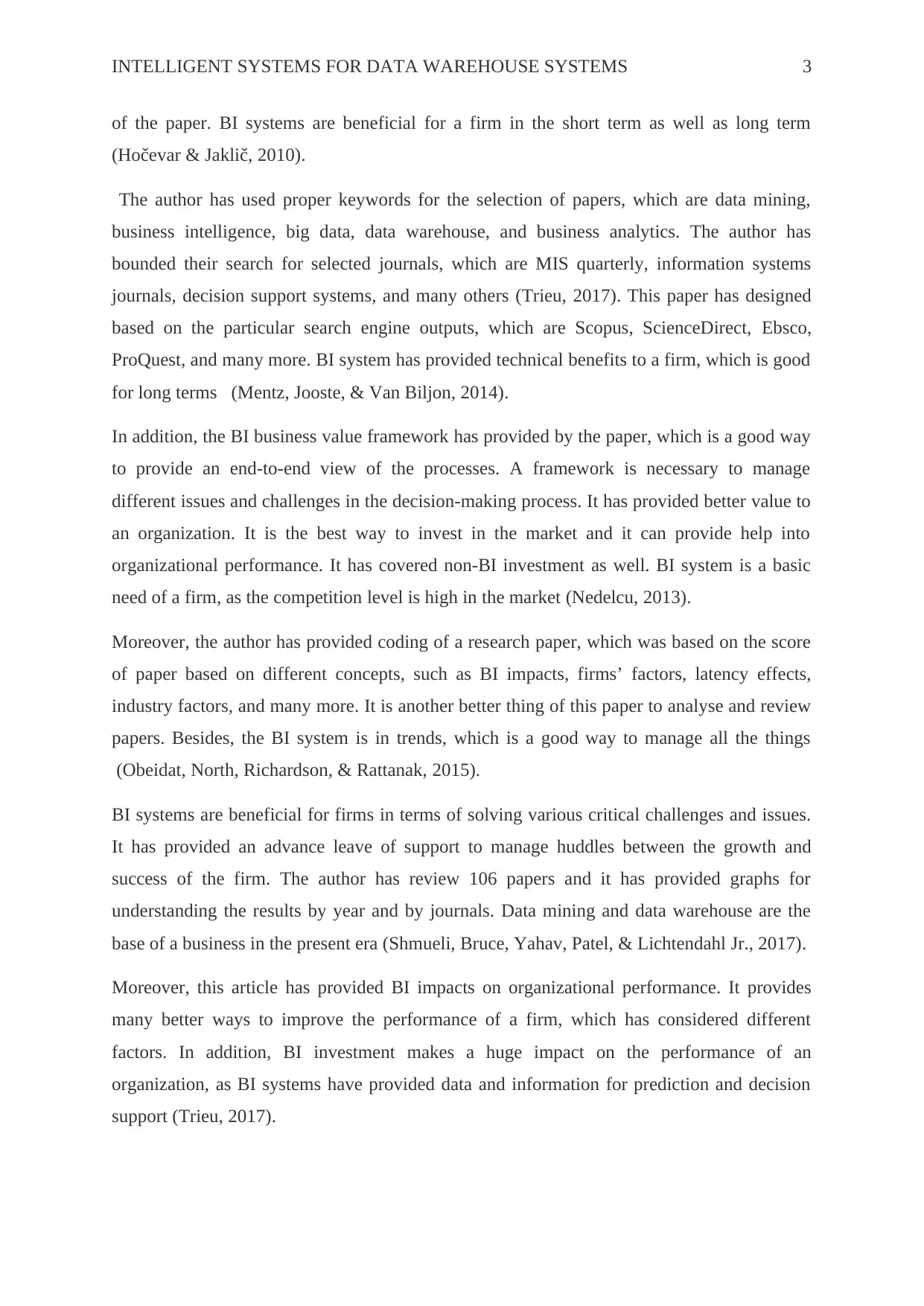
INTELLIGENT SYSTEMS FOR DATA WAREHOUSE SYSTEMS 3
of the paper. BI systems are beneficial for a firm in the short term as well as long term
(Hočevar & Jaklič, 2010).
The author has used proper keywords for the selection of papers, which are data mining,
business intelligence, big data, data warehouse, and business analytics. The author has
bounded their search for selected journals, which are MIS quarterly, information systems
journals, decision support systems, and many others (Trieu, 2017). This paper has designed
based on the particular search engine outputs, which are Scopus, ScienceDirect, Ebsco,
ProQuest, and many more. BI system has provided technical benefits to a firm, which is good
for long terms (Mentz, Jooste, & Van Biljon, 2014).
In addition, the BI business value framework has provided by the paper, which is a good way
to provide an end-to-end view of the processes. A framework is necessary to manage
different issues and challenges in the decision-making process. It has provided better value to
an organization. It is the best way to invest in the market and it can provide help into
organizational performance. It has covered non-BI investment as well. BI system is a basic
need of a firm, as the competition level is high in the market (Nedelcu, 2013).
Moreover, the author has provided coding of a research paper, which was based on the score
of paper based on different concepts, such as BI impacts, firms’ factors, latency effects,
industry factors, and many more. It is another better thing of this paper to analyse and review
papers. Besides, the BI system is in trends, which is a good way to manage all the things
(Obeidat, North, Richardson, & Rattanak, 2015).
BI systems are beneficial for firms in terms of solving various critical challenges and issues.
It has provided an advance leave of support to manage huddles between the growth and
success of the firm. The author has review 106 papers and it has provided graphs for
understanding the results by year and by journals. Data mining and data warehouse are the
base of a business in the present era (Shmueli, Bruce, Yahav, Patel, & Lichtendahl Jr., 2017).
Moreover, this article has provided BI impacts on organizational performance. It provides
many better ways to improve the performance of a firm, which has considered different
factors. In addition, BI investment makes a huge impact on the performance of an
organization, as BI systems have provided data and information for prediction and decision
support (Trieu, 2017).
of the paper. BI systems are beneficial for a firm in the short term as well as long term
(Hočevar & Jaklič, 2010).
The author has used proper keywords for the selection of papers, which are data mining,
business intelligence, big data, data warehouse, and business analytics. The author has
bounded their search for selected journals, which are MIS quarterly, information systems
journals, decision support systems, and many others (Trieu, 2017). This paper has designed
based on the particular search engine outputs, which are Scopus, ScienceDirect, Ebsco,
ProQuest, and many more. BI system has provided technical benefits to a firm, which is good
for long terms (Mentz, Jooste, & Van Biljon, 2014).
In addition, the BI business value framework has provided by the paper, which is a good way
to provide an end-to-end view of the processes. A framework is necessary to manage
different issues and challenges in the decision-making process. It has provided better value to
an organization. It is the best way to invest in the market and it can provide help into
organizational performance. It has covered non-BI investment as well. BI system is a basic
need of a firm, as the competition level is high in the market (Nedelcu, 2013).
Moreover, the author has provided coding of a research paper, which was based on the score
of paper based on different concepts, such as BI impacts, firms’ factors, latency effects,
industry factors, and many more. It is another better thing of this paper to analyse and review
papers. Besides, the BI system is in trends, which is a good way to manage all the things
(Obeidat, North, Richardson, & Rattanak, 2015).
BI systems are beneficial for firms in terms of solving various critical challenges and issues.
It has provided an advance leave of support to manage huddles between the growth and
success of the firm. The author has review 106 papers and it has provided graphs for
understanding the results by year and by journals. Data mining and data warehouse are the
base of a business in the present era (Shmueli, Bruce, Yahav, Patel, & Lichtendahl Jr., 2017).
Moreover, this article has provided BI impacts on organizational performance. It provides
many better ways to improve the performance of a firm, which has considered different
factors. In addition, BI investment makes a huge impact on the performance of an
organization, as BI systems have provided data and information for prediction and decision
support (Trieu, 2017).
Paraphrase This Document
Need a fresh take? Get an instant paraphrase of this document with our AI Paraphraser
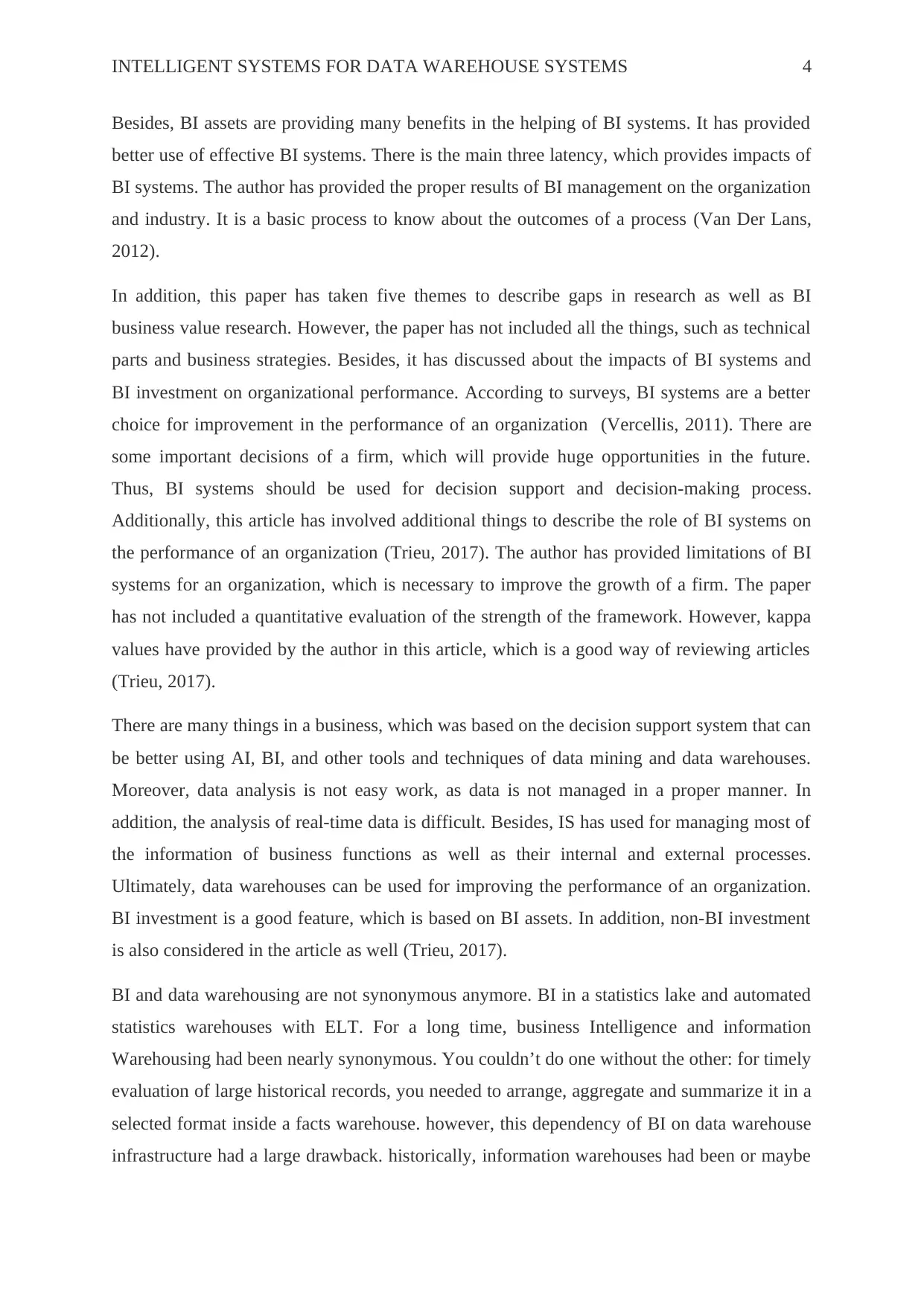
INTELLIGENT SYSTEMS FOR DATA WAREHOUSE SYSTEMS 4
Besides, BI assets are providing many benefits in the helping of BI systems. It has provided
better use of effective BI systems. There is the main three latency, which provides impacts of
BI systems. The author has provided the proper results of BI management on the organization
and industry. It is a basic process to know about the outcomes of a process (Van Der Lans,
2012).
In addition, this paper has taken five themes to describe gaps in research as well as BI
business value research. However, the paper has not included all the things, such as technical
parts and business strategies. Besides, it has discussed about the impacts of BI systems and
BI investment on organizational performance. According to surveys, BI systems are a better
choice for improvement in the performance of an organization (Vercellis, 2011). There are
some important decisions of a firm, which will provide huge opportunities in the future.
Thus, BI systems should be used for decision support and decision-making process.
Additionally, this article has involved additional things to describe the role of BI systems on
the performance of an organization (Trieu, 2017). The author has provided limitations of BI
systems for an organization, which is necessary to improve the growth of a firm. The paper
has not included a quantitative evaluation of the strength of the framework. However, kappa
values have provided by the author in this article, which is a good way of reviewing articles
(Trieu, 2017).
There are many things in a business, which was based on the decision support system that can
be better using AI, BI, and other tools and techniques of data mining and data warehouses.
Moreover, data analysis is not easy work, as data is not managed in a proper manner. In
addition, the analysis of real-time data is difficult. Besides, IS has used for managing most of
the information of business functions as well as their internal and external processes.
Ultimately, data warehouses can be used for improving the performance of an organization.
BI investment is a good feature, which is based on BI assets. In addition, non-BI investment
is also considered in the article as well (Trieu, 2017).
BI and data warehousing are not synonymous anymore. BI in a statistics lake and automated
statistics warehouses with ELT. For a long time, business Intelligence and information
Warehousing had been nearly synonymous. You couldn’t do one without the other: for timely
evaluation of large historical records, you needed to arrange, aggregate and summarize it in a
selected format inside a facts warehouse. however, this dependency of BI on data warehouse
infrastructure had a large drawback. historically, information warehouses had been or maybe
Besides, BI assets are providing many benefits in the helping of BI systems. It has provided
better use of effective BI systems. There is the main three latency, which provides impacts of
BI systems. The author has provided the proper results of BI management on the organization
and industry. It is a basic process to know about the outcomes of a process (Van Der Lans,
2012).
In addition, this paper has taken five themes to describe gaps in research as well as BI
business value research. However, the paper has not included all the things, such as technical
parts and business strategies. Besides, it has discussed about the impacts of BI systems and
BI investment on organizational performance. According to surveys, BI systems are a better
choice for improvement in the performance of an organization (Vercellis, 2011). There are
some important decisions of a firm, which will provide huge opportunities in the future.
Thus, BI systems should be used for decision support and decision-making process.
Additionally, this article has involved additional things to describe the role of BI systems on
the performance of an organization (Trieu, 2017). The author has provided limitations of BI
systems for an organization, which is necessary to improve the growth of a firm. The paper
has not included a quantitative evaluation of the strength of the framework. However, kappa
values have provided by the author in this article, which is a good way of reviewing articles
(Trieu, 2017).
There are many things in a business, which was based on the decision support system that can
be better using AI, BI, and other tools and techniques of data mining and data warehouses.
Moreover, data analysis is not easy work, as data is not managed in a proper manner. In
addition, the analysis of real-time data is difficult. Besides, IS has used for managing most of
the information of business functions as well as their internal and external processes.
Ultimately, data warehouses can be used for improving the performance of an organization.
BI investment is a good feature, which is based on BI assets. In addition, non-BI investment
is also considered in the article as well (Trieu, 2017).
BI and data warehousing are not synonymous anymore. BI in a statistics lake and automated
statistics warehouses with ELT. For a long time, business Intelligence and information
Warehousing had been nearly synonymous. You couldn’t do one without the other: for timely
evaluation of large historical records, you needed to arrange, aggregate and summarize it in a
selected format inside a facts warehouse. however, this dependency of BI on data warehouse
infrastructure had a large drawback. historically, information warehouses had been or maybe
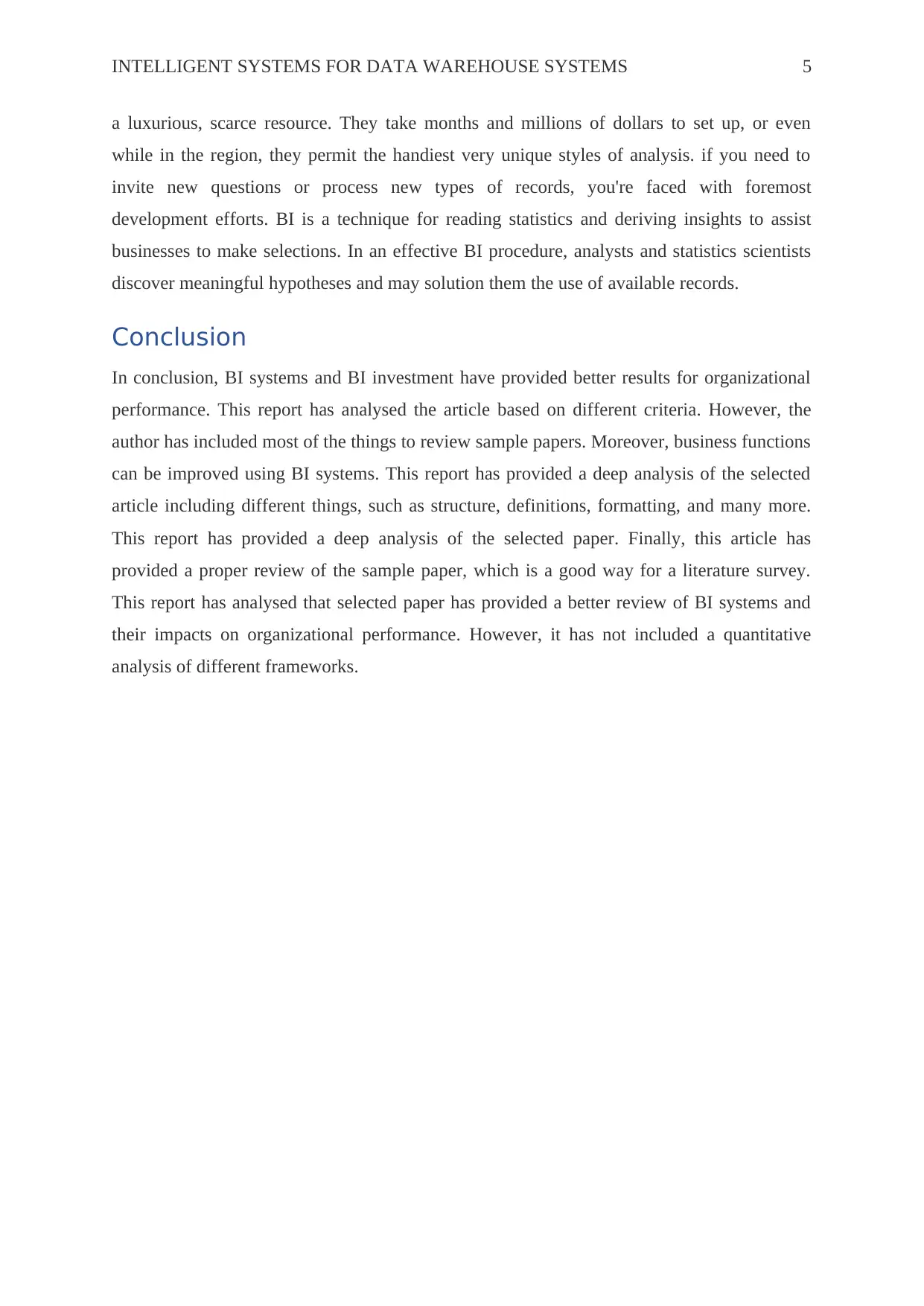
INTELLIGENT SYSTEMS FOR DATA WAREHOUSE SYSTEMS 5
a luxurious, scarce resource. They take months and millions of dollars to set up, or even
while in the region, they permit the handiest very unique styles of analysis. if you need to
invite new questions or process new types of records, you're faced with foremost
development efforts. BI is a technique for reading statistics and deriving insights to assist
businesses to make selections. In an effective BI procedure, analysts and statistics scientists
discover meaningful hypotheses and may solution them the use of available records.
Conclusion
In conclusion, BI systems and BI investment have provided better results for organizational
performance. This report has analysed the article based on different criteria. However, the
author has included most of the things to review sample papers. Moreover, business functions
can be improved using BI systems. This report has provided a deep analysis of the selected
article including different things, such as structure, definitions, formatting, and many more.
This report has provided a deep analysis of the selected paper. Finally, this article has
provided a proper review of the sample paper, which is a good way for a literature survey.
This report has analysed that selected paper has provided a better review of BI systems and
their impacts on organizational performance. However, it has not included a quantitative
analysis of different frameworks.
a luxurious, scarce resource. They take months and millions of dollars to set up, or even
while in the region, they permit the handiest very unique styles of analysis. if you need to
invite new questions or process new types of records, you're faced with foremost
development efforts. BI is a technique for reading statistics and deriving insights to assist
businesses to make selections. In an effective BI procedure, analysts and statistics scientists
discover meaningful hypotheses and may solution them the use of available records.
Conclusion
In conclusion, BI systems and BI investment have provided better results for organizational
performance. This report has analysed the article based on different criteria. However, the
author has included most of the things to review sample papers. Moreover, business functions
can be improved using BI systems. This report has provided a deep analysis of the selected
article including different things, such as structure, definitions, formatting, and many more.
This report has provided a deep analysis of the selected paper. Finally, this article has
provided a proper review of the sample paper, which is a good way for a literature survey.
This report has analysed that selected paper has provided a better review of BI systems and
their impacts on organizational performance. However, it has not included a quantitative
analysis of different frameworks.
⊘ This is a preview!⊘
Do you want full access?
Subscribe today to unlock all pages.

Trusted by 1+ million students worldwide
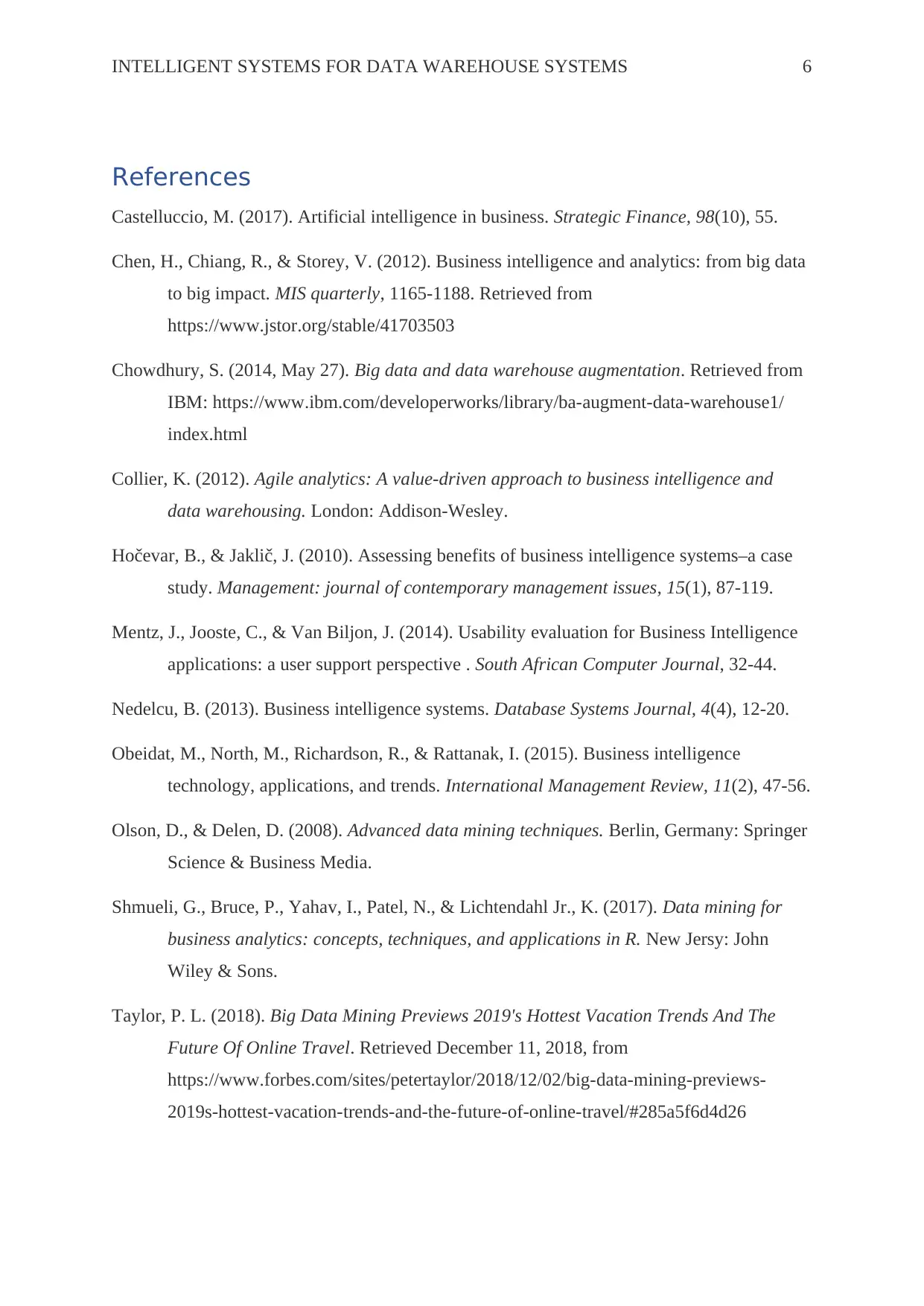
INTELLIGENT SYSTEMS FOR DATA WAREHOUSE SYSTEMS 6
References
Castelluccio, M. (2017). Artificial intelligence in business. Strategic Finance, 98(10), 55.
Chen, H., Chiang, R., & Storey, V. (2012). Business intelligence and analytics: from big data
to big impact. MIS quarterly, 1165-1188. Retrieved from
https://www.jstor.org/stable/41703503
Chowdhury, S. (2014, May 27). Big data and data warehouse augmentation. Retrieved from
IBM: https://www.ibm.com/developerworks/library/ba-augment-data-warehouse1/
index.html
Collier, K. (2012). Agile analytics: A value-driven approach to business intelligence and
data warehousing. London: Addison-Wesley.
Hočevar, B., & Jaklič, J. (2010). Assessing benefits of business intelligence systems–a case
study. Management: journal of contemporary management issues, 15(1), 87-119.
Mentz, J., Jooste, C., & Van Biljon, J. (2014). Usability evaluation for Business Intelligence
applications: a user support perspective . South African Computer Journal, 32-44.
Nedelcu, B. (2013). Business intelligence systems. Database Systems Journal, 4(4), 12-20.
Obeidat, M., North, M., Richardson, R., & Rattanak, I. (2015). Business intelligence
technology, applications, and trends. International Management Review, 11(2), 47-56.
Olson, D., & Delen, D. (2008). Advanced data mining techniques. Berlin, Germany: Springer
Science & Business Media.
Shmueli, G., Bruce, P., Yahav, I., Patel, N., & Lichtendahl Jr., K. (2017). Data mining for
business analytics: concepts, techniques, and applications in R. New Jersy: John
Wiley & Sons.
Taylor, P. L. (2018). Big Data Mining Previews 2019's Hottest Vacation Trends And The
Future Of Online Travel. Retrieved December 11, 2018, from
https://www.forbes.com/sites/petertaylor/2018/12/02/big-data-mining-previews-
2019s-hottest-vacation-trends-and-the-future-of-online-travel/#285a5f6d4d26
References
Castelluccio, M. (2017). Artificial intelligence in business. Strategic Finance, 98(10), 55.
Chen, H., Chiang, R., & Storey, V. (2012). Business intelligence and analytics: from big data
to big impact. MIS quarterly, 1165-1188. Retrieved from
https://www.jstor.org/stable/41703503
Chowdhury, S. (2014, May 27). Big data and data warehouse augmentation. Retrieved from
IBM: https://www.ibm.com/developerworks/library/ba-augment-data-warehouse1/
index.html
Collier, K. (2012). Agile analytics: A value-driven approach to business intelligence and
data warehousing. London: Addison-Wesley.
Hočevar, B., & Jaklič, J. (2010). Assessing benefits of business intelligence systems–a case
study. Management: journal of contemporary management issues, 15(1), 87-119.
Mentz, J., Jooste, C., & Van Biljon, J. (2014). Usability evaluation for Business Intelligence
applications: a user support perspective . South African Computer Journal, 32-44.
Nedelcu, B. (2013). Business intelligence systems. Database Systems Journal, 4(4), 12-20.
Obeidat, M., North, M., Richardson, R., & Rattanak, I. (2015). Business intelligence
technology, applications, and trends. International Management Review, 11(2), 47-56.
Olson, D., & Delen, D. (2008). Advanced data mining techniques. Berlin, Germany: Springer
Science & Business Media.
Shmueli, G., Bruce, P., Yahav, I., Patel, N., & Lichtendahl Jr., K. (2017). Data mining for
business analytics: concepts, techniques, and applications in R. New Jersy: John
Wiley & Sons.
Taylor, P. L. (2018). Big Data Mining Previews 2019's Hottest Vacation Trends And The
Future Of Online Travel. Retrieved December 11, 2018, from
https://www.forbes.com/sites/petertaylor/2018/12/02/big-data-mining-previews-
2019s-hottest-vacation-trends-and-the-future-of-online-travel/#285a5f6d4d26
Paraphrase This Document
Need a fresh take? Get an instant paraphrase of this document with our AI Paraphraser

INTELLIGENT SYSTEMS FOR DATA WAREHOUSE SYSTEMS 7
Trieu, V.-H. (2017). Getting value from Business Intelligence systems: A review and
research agenda. Decision Support Systems, 93, 111-124.
doi:https://doi.org/10.1016/j.dss.2016.09.019
Van Der Lans, R. (2012). Data Virtualization for business intelligence systems:
revolutionizing data integration for data warehouses. London: Elsevier.
Vercellis, C. (2011). Business intelligence: data mining and optimization for decision
making. New Jersy: John Wiley & Sons.
Trieu, V.-H. (2017). Getting value from Business Intelligence systems: A review and
research agenda. Decision Support Systems, 93, 111-124.
doi:https://doi.org/10.1016/j.dss.2016.09.019
Van Der Lans, R. (2012). Data Virtualization for business intelligence systems:
revolutionizing data integration for data warehouses. London: Elsevier.
Vercellis, C. (2011). Business intelligence: data mining and optimization for decision
making. New Jersy: John Wiley & Sons.
1 out of 8
Related Documents
Your All-in-One AI-Powered Toolkit for Academic Success.
+13062052269
info@desklib.com
Available 24*7 on WhatsApp / Email
![[object Object]](/_next/static/media/star-bottom.7253800d.svg)
Unlock your academic potential
Copyright © 2020–2025 A2Z Services. All Rights Reserved. Developed and managed by ZUCOL.





